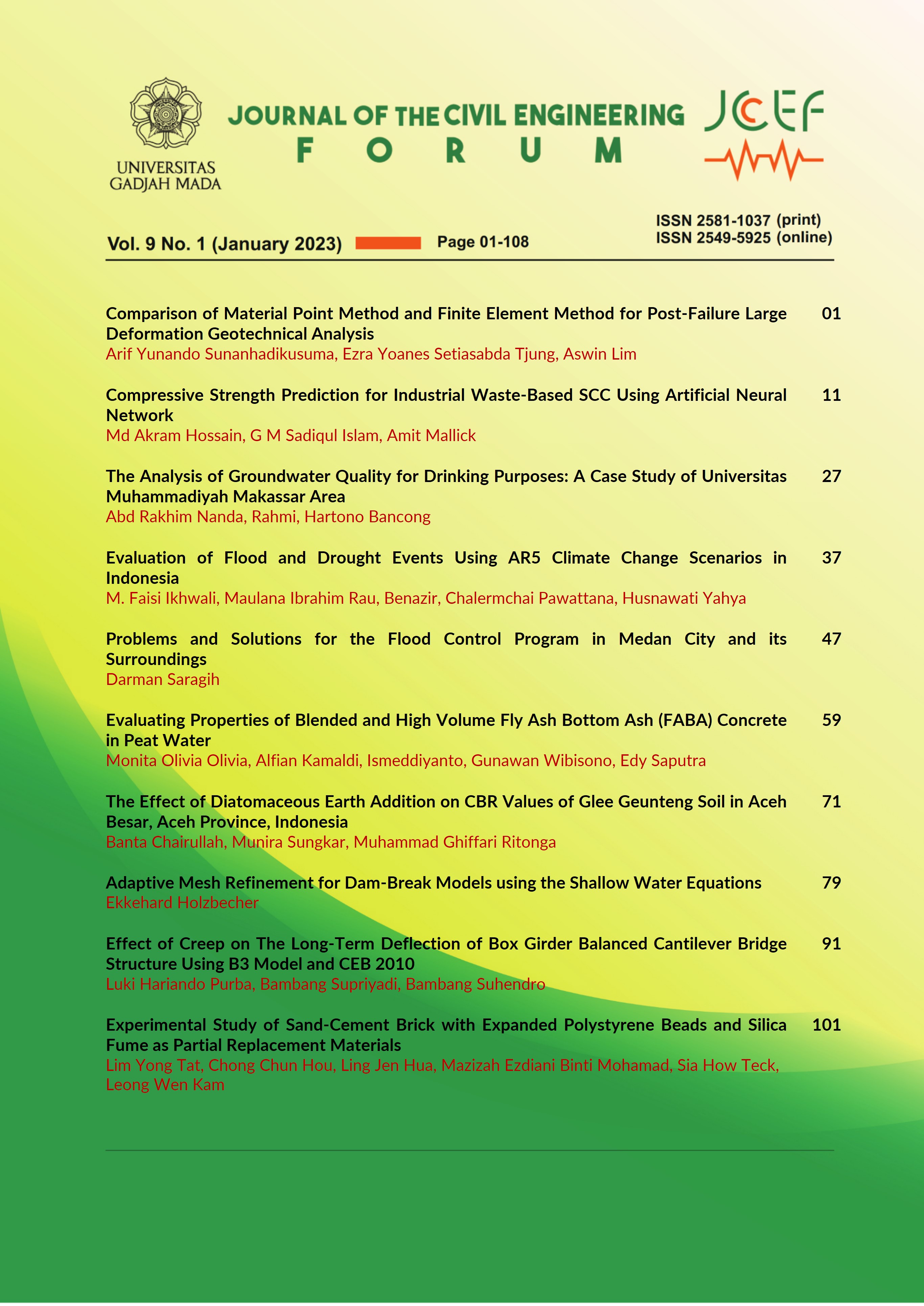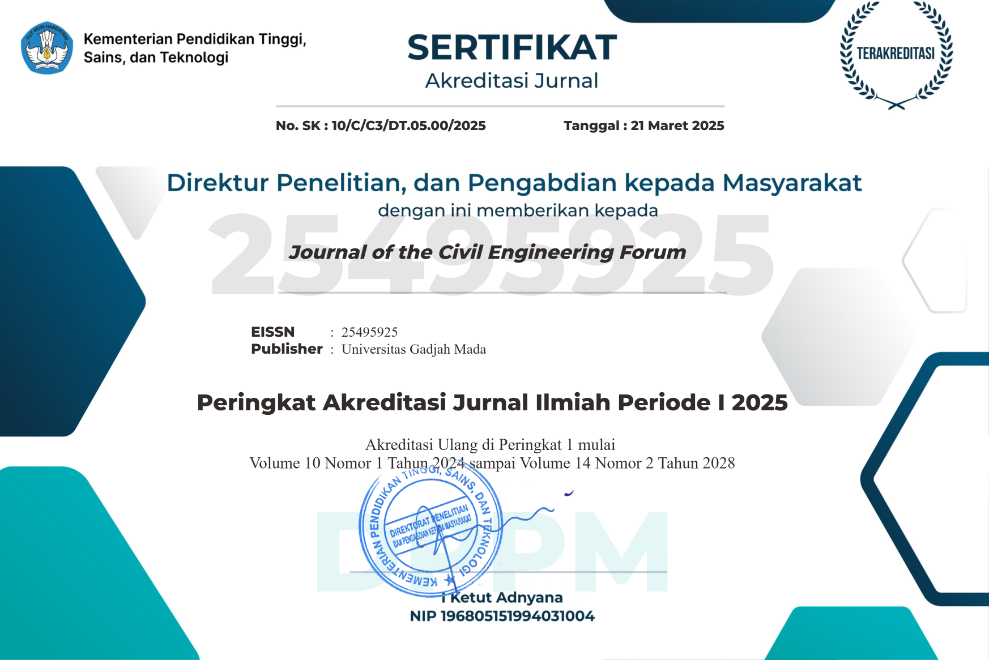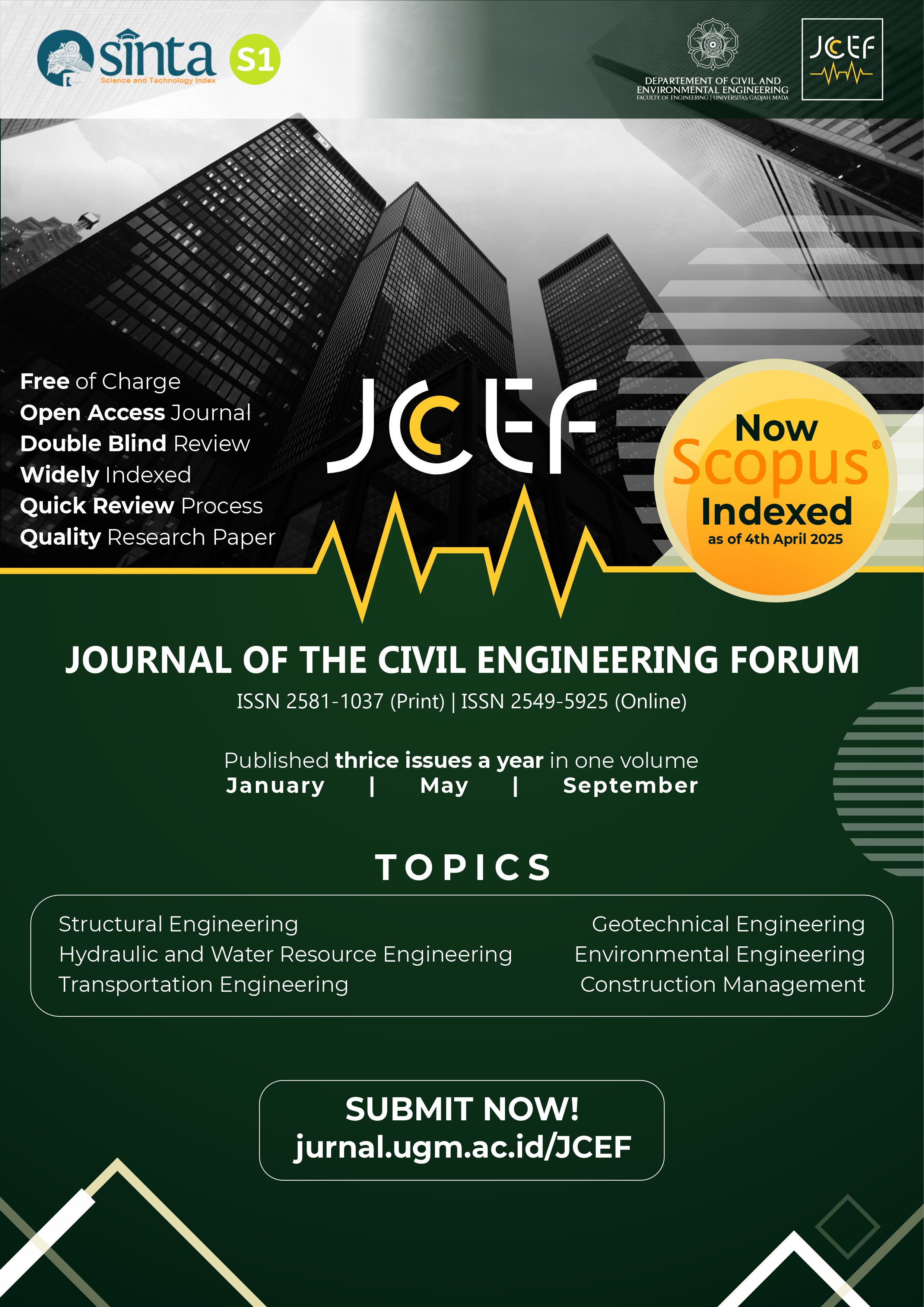Compressive Strength Prediction for Industrial Waste-Based SCC Using Artificial Neural Network
Abstract
Concrete is the most used construction material in the world. Sustainable construction practice demands durable material. A particular type of concrete that flows and consolidates under its weight is proposed to reduce labor dependency during construction, called self-compacting concrete. It is installed without vibration due to its excellent deformability and flowability while remaining cohesive enough to be treated without difficulty. Evaluating its compressive strength is essential as it is used in important construction projects. An artificial neural network (ANN) is a predicting tool that can predict output in various sectors. This study evaluated the compressive strength of industrial waste such as fly ash and silica fume incorporated in self-compacting concrete at various ages. A non-linear relationship was used to develop the model relating mix composition and SCC compressive strength using an Artificial Neural Network (ANN). The experimental and expected outcomes were compared with the model prediction to evaluate the predictive capacity, generalize the generated model, and observe suitable matches. The developed ANN network can predict the desired output, i.e., compressive strength incorporating industrial waste. Furthermore, the influence of individual parameters viz. cement, silica fume, and fly ash, w/b were also evaluated using parametric analysis, which shows the sensitivity of various materials on the compressive strength of Self-compacting concrete. As a result, a higher correlation coefficient of 0.9835 with a smaller value of MAPE (0.0347) and RMSE (2.4503) is obtained. Finally, a process of creating tools for practical engineers and field users is proposed, which would be very handy and fast for predicting the strength of SCC.
References
Ahmad, J., Ihsan, M. T., Manan, A., Zaid, O., Ul-lah, R. and Abbas, G. (2020), ‘Evaluating the effect of fly ash on the rheological and mechanical performance self-compacted concrete’, p. 10.
Aicha, M. B. (2020), The superplasticizer effect on the rheological and mechanical properties of self-compacting concrete, in ‘New Materials in Civil Engineering’, Elsevier, pp. 315–331. https://doi.org/10.1016/b978-0-12-818961-0.00008-9
Al-Hadithi, A. I. and Hilal, N. N. (2016), ‘The possibility of enhancing some properties of self-compacting concrete by adding waste plastic fibers’, Journal of Building Engineering 8, 20–28. https://doi.org/10.1016/j.jobe.2016.06.011
American Concrete Institute (2019), ‘Aci prc-237-07 self-consolidating concrete’, p. 30. https://www.concrete.org/store/productdetail.aspx?ItemID=23707Format=DOWNLOADLanguage=EnglishUnits=US_AND_METRIC
Apostolopoulou, M., Armaghani, D. J., Bakolas, A., Douvika, M. G., Moropoulou, A. and Asteris, P. G. (2019), 'Compressive strength of natural hydraulic lime mortars using soft computing techniques’, Procedia Structural Integrity 17, 914–923. https://doi.org/10.1016/j.prostr.2019.08.122
Armaghani, D. J., Hatzigeorgiou, G. D., Karamani, C., Skentou, A., Zoumpoulaki, I. and Asteris, P. G. (2019), ‘Soft computing-based techniques for concrete beams shear strength’, Procedia Structural Integrity 17, 924–933. https://doi.org/10.1016/j.prostr.2019.08.123
Ashteyat, A. A. and Ismeik, M. (2018), ‘Predicting residual compressive strength of self-compacted concrete under various temperatures and relative humidity conditions by artificial neural networks’, Computers and Concrete, 21(1) p. 47. https://doi.org/10.12989/CAC.2018.21.1.047
Asteris, P. G., Apostolopoulou, M., Skentou, A. D. and Moropoulou, A. (2019), ‘Predicting application of artificial neural networks for the prediction of the compressive strength of cement-based mortars’, Computers and Concrete, 24(4) p. 329. https://doi.org/10.12989/CAC.2019.24.4.329
Asteris, P. G., Armaghani, D. J., Hatzigeorgiou, G. D., Karayannis, C. G. and Pilakoutas, K. (2019), ‘Predicting the shear strength of reinforced concrete beams using artificial neural networks’, Computers and Concrete, 24(5) p. 469. https://doi.org/10.12989/CAC.2019.24.5.469
Asteris, P. G., Tsaris, A. K., Cavaleri, L., Repapis, C. C., Papalou, A., Trapani, F. D. and Karypidis, D. F. (2016), ‘Prediction of the fundamental period of infilled RC frame structures using artificial neural networks’, Computational Intelligence and Neuroscience 2016, 1–12. https://doi.org/10.1155/2016/5104907
Aïtcin, P.-C. (1995), ‘Developments in the application of high-performance concretes’, Construction and Building Materials 9(1), 13–17. https://doi.org/10.1016/0950-0618(95)92855-b
Banthia, N. and Onuaguluchi, O. (2021), ‘Recycling scrap tire-derived fibers in concrete’, Transactions of the Indian National Academy of Engineering 7(1), 207–217. https://doi.org/10.1007/s41403-021-00257-4
Beaudoin, J. and Odler, I. (2019), Hydration, setting and hardening of portland cement, in ‘Lea's Chemistry of Cement and Concrete’, Elsevier, pp. 157–250. https://doi.org/10.1016/b978-0-08-100773-0.00005-8
Cavaleri, L., Chatzarakis, G. E., Trapani, F. D., Douvika, M. G., Roinos, K., Vaxevanidis, N. M. and Asteris, P. G. (2017), ‘Modeling of surface roughness in electro-discharge machining using artificial neural networks’, Advances in Materials Research (South Korea), 6(2) p. 169–184. https://doi.org/10.12989/amr.2017.6.2.169
Chandra, S. and Bendapudi, K. (2015), ‘Contribution of fly ash to the properties of mortar and concrete’, International Journal of Earth Sciences and Engineering, 04(October 2011) p. 1017–1023.
Chugh, A. (n.d.), ‘Coefficient of determination, adjusted r squared — which metric is better?’.
Deilami, S., Aslani, F. and Elchalakani, M. (2017), ‘Durability assessment of self-compacting concrete with fly ash’, Computers and Concrete, 19(5) p. 489. https://doi.org/10.12989/CAC.2017.19.5.489
Grünewald, S. and Walraven, J. C. (2001), ‘Parameter-study on the influence of steel fibers and coarse aggregate content on the fresh properties of self-compacting concrete’, Cement and Concrete Research 31(12), 1793–1798. https://doi.org/10.1016/s0008-8846(01)00555-5
Heniegal, A. M. (2012), ‘Numerical analysis for predicting of self compacting concrete mixtures using artificial neural networks’, JES. Journal of Engineering Sciences 40(6), 1575–1597. https://doi.org/10.21608/jesaun.2012.114530
Hinton, G. E., Osindero, S. and Teh, Y.-W. (2006), ‘A fast learning algorithm for deep belief nets’, Neural Computation 18(7), 1527–1554. https://doi.org/10.1162/neco.2006.18.7.1527
Hodhod, O. A., Said, T. E. and Ataya, A. M. (2018), ‘Prediction of creep in concrete using genetic programming hybridized with ann’, Computers and Concrete, 21(5) p. 513. https://doi.org/10.12989/CAC.2018.21.5.513
Hornik, K., Stinchcombe, M. and White, H. (1989), ‘Multilayer feedforward networks are universal approximators’, Neural Networks 2(5), 359–366. https://doi.org/10.1016/0893-6080(89)90020-8
Intezar, T. M., Haque, S., Islam, G. M. S.and Roy, S. and Mushfiq, M. (2019), ‘Properties of self-compacting concrete using fly ash and polypropylene fibre’, 5th International Conference on Engineering Research, Innovation and Education ICERIE 2019.
Islam, G. M. S., Raihan, M. T., Hasan, M. M. and Rashadin, M. (2019), ‘Effect of retarding super-plasticizers on the properties of cement paste, mortar and concrete’, Asian Journal of Civil Engineering 20(4), 591–601. https://doi.org/10.1007/s42107-019-00128-y
Joshi, R. C. and Lohtia, R. P. (1997), ‘Fly ash in concrete, production, properties and uses’, Advances in Concrete technology (Volume 2) .
Lee, S. C. and Han, S. W. (2002), ‘Neural-network-based models for generating artificial earthquakes and response spectra’, Computers & Structures 80(20-21), 1627–1638. https://doi.org/10.1016/s0045-7949(02)00112-8
Lee, S. C., Park, S. K. and Lee, B. H. (2001), ‘Development of the approximate analytical model for the stub-girder system using neural networks’, Computers & Structures 79(10), 1013–1025. https://doi.org/10.1016/s0045-7949(00)00199-1
Levy, S. M. (2012), Calculations relating to concrete and masonry, in ‘Construction Calculations Manual’, Elsevier, pp. 211–264. https://doi.org/10.1016/b978-0-12-382243-7.00005-x
Lourakis, M. (2005), ‘A brief description of the levenberg-marquardt algorithm implemened by levmar’, Matrix, 3(January 2005) p. 2.
Mazloom, M., Soltani, A., karamloo, M., Hassan-loo, A. and Ranjbar, A. (2018), ‘Effects of silica fume, superplasticizer dosage and type of superplasticizer on the properties of normal and self-compacting concrete’, Advances in Materials Research, 7(1) p. 45. https://doi.org/10.12989/AMR.2018.7.1.045
Mazloom, M. and Yoosefi, M. M. (2013), ‘Predicting the indirect tensile strength of self-compacting concrete using artificial neural networks’, Computers and Concrete, 12(3) p. 285. https://doi.org/10.12989/CAC.2013.12.3.285
McCarthy, M. J., Islam, G. M. S., Csetenyi, L. J. and Jones, M. R. (2013), ‘Evaluating test methods for rapidly assessing fly ash reactivity for use in concrete’, World of Coal Ash Conference, April 22-25.
Moghadam, M. A. and Izadifard, R. A. (2019), ‘Experimental investigation on the effect of silica fume and zeolite on mechanical and durability properties of concrete at high temperatures’, SN Applied Sciences 1(7). https://doi.org/10.1007/s42452-019-0739-2
Mohammadhosseini, H. and Yatim, J. M. (2017), ‘Evaluation of the effective mechanical properties of concrete composites using industrial waste carpet fiber’, INAE Letters 2(1), 1–12. https://doi.org/10.1007/s41403-017-0016-x
Naik, T. R., Kumar, R., Ramme, B. W. and Canpolat, F. (2012), ‘Development of high-strength, economical self-consolidating concrete’, Construction and Building Materials 30, 463–469. https://doi.org/10.1016/j.conbuildmat.2011.12.025
Neville, A. M. (2011), Properties of Concrete (5th ed.). Pearson Education Limited.
Nguyen, T. T., Duy, H. P., Thanh, T. P. and Vu, H. H. (2020), ‘Compressive strength evaluation of fiber-reinforced high-strength self-compacting concrete with artificial intelligence’, Advances in Civil Engineering 2020, 1–12. https://doi.org/10.1155/2020/3012139
Nikoo, M., Sadowski, Ł., Khademi, F. and Nikoo, M. (2017), ‘Determination of damage in reinforced concrete frames with shear walls using self-organizing feature map’, Applied Computational Intelligence and Soft Computing 2017, 1–10. https://doi.org/10.1155/2017/3508189
Okamura, H. and Ouchi, M. (2003), ‘Self-compacting concrete’, Journal of Advanced Concrete Technology 1(1), 5–15. https://doi.org/10.3151/jact.1.5
Raheman, A. and Modani, P. O. (2013), Prediction of Properties of Self Compacting Concrete Using Artificial Neural Network. 3(4) pp. 333–339.
Saini, G. and Vattipalli, U. (2020), ‘Assessing properties of alkali activated GGBS based self-compacting geopolymer concrete using nano-silica’, Case Studies in Construction Materials 12, e00352. https://doi.org/10.1016/j.cscm.2020.e00352
Schmidhuber, J. (2015), ‘Deep learning in neural networks: An overview’, Neural Networks 61, 85–117. https://doi.org/10.1016/j.neunet.2014.09.003
Siddique, R. (2011), ‘Properties of self-compacting concrete containing class f fly ash’, Materials & Design 32(3), 1501–1507. https://doi.org/10.1016/j.matdes.2010.08.043
Siddique, R., Aggarwal, P., Aggarwal, Y. and Gupta, S. M. (2008), ‘Modeling properties of self-compacting concrete: support vector machines approach’, Computers and Concrete, 5(5) p. 461. https://doi.org/10.12989/CAC.2008.5.5.461
Taylor, J. G., ed. (1992), Neural Network Applications, Springer London. https://doi.org/10.1007/978-1-4471-2003-2
Turk, K., Karatas, M. and Gonen, T. (2012), ‘Effect of fly ash and silica fume on compressive strength, sorptivity and carbonation of SCC’, KSCE Journal of Civil Engineering 17(1), 202–209. https://doi.org/10.1007/s12205-013-1680-3
Uysal, M. and Tanyildizi, H. (2011), ‘Predicting the core compressive strength of self-compacting concrete (SCC) mixtures with mineral additives using artificial neural network’, Construction and Building Materials 25(11), 4105–4111. https://doi.org/10.1016/j.conbuildmat.2010.11.108
Yadollahi, M. M., Benli, A. and Demirboğa, R. (2015), ‘Prediction of compressive strength of geopolymer composites using an artificial neural network’, Materials Research Innovations 19(6), 453–458. https://doi.org/10.1179/1433075x15y.0000000020
Ye, X. W., Jin, T. and Yun, C. B. (2019), ‘A review on deep learning-based structural health monitoring of civil infrastructures’, Smart Structures and Systems, 24(5) p. 567. https://doi.org/10.12989/SSS.2019.24.5.567
Copyright (c) 2023 The Author(s)

This work is licensed under a Creative Commons Attribution-ShareAlike 4.0 International License.
Copyright is granted to authors for the purpose of providing protection for articles written to describe experiments and their results. JCEF will protect and defend the work and reputation of the author and are also willing to address any allegations of violation, plagiarism, fraud, etc. against articles written and published by JCEF. JCEF is published under the terms of the Creative Commons Attribution-ShareAlike 4.0 International License (CC BY-SA 4.0). The author holds the copyright and assigns the journal rights to the first publication (online and print) of the work simultaneously.







